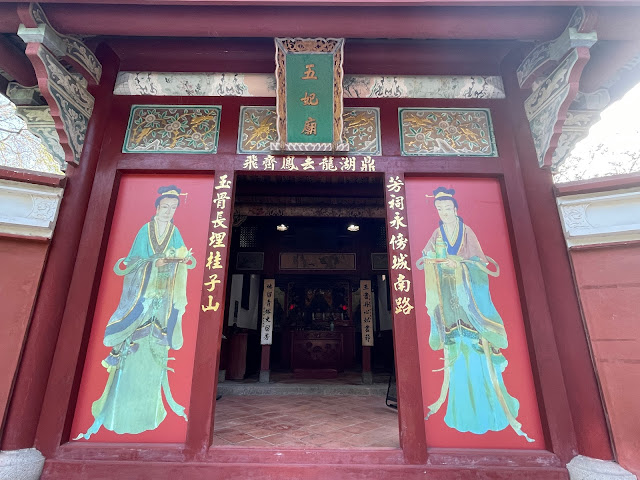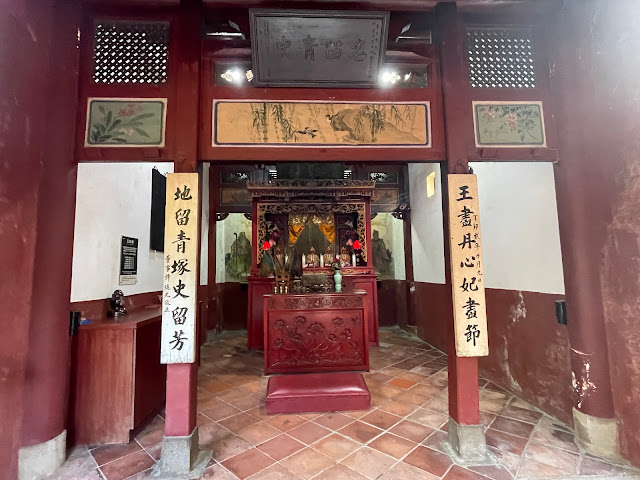We were invited to give a guest speech at Tainan Vocational School, but we forgot to give them the receipt for the ingredients we purchased. A few days later, while driving back home, we stumbled upon a temple. Sometimes I'm amazed that there are still new places to discover in the city. I feel like I've seen most of the ancient buildings already, as we have been exploring based on Google Maps. This temple is not unusual, as there is a grave behind it. I found many more places to visit in the future, mostly small places like ancient homes and remnants of the Japanese occupation, but in the last three months, we haven't had much time to go out. It seems my husband will be working in Hsinchu for two months longer than expected, so we still don't have much time for travel currently. Hopefully, in the summer, we can visit the east of Taiwan again or explore some other islands.
See also: Speech at Tainan Vocational School
Five Concubines Temple (五妃廟)
The Wufei Temple, also known as the Temple of the Five Concubines. It is a national historic monument with over 300 years of history. The temple is associated with the burial of the five honorable concubines of Prince Ningjing from the late Ming Dynasty. Originally, the temple was located at Kuidou Mountain, but it is now situated elsewhere. In the past, the area surrounding the temple was deserted, with a narrow track leading to it and overgrown weeds. It was often referred to as the "Ghost Mountain" due to the rare traces of human presence.
Wufei Temple faces northeast and has a single entry and two wings, known as the "protector dragons." The main hall is dedicated to the statues of the five concubines, with a stone tablet embedded on the wall behind them inscribed with "Grave of the Five Concubines of Prince Ningjing." Behind the temple is a burial mound surrounded by grass. The death of the five concubines symbolized great sacrifice and loyalty, and subsequent generations composed poems praising their devotion. The tomb passage, built in 1746 and inscribed with 10 quatrains by Fan Xian, a patrolling inspector of Taiwan, is still preserved in the Great South Gate Forest of Steles.
During the Qing Dynasty, the descendants of the concubines renamed the temple the Wufei Temple to honor their loyalty. In 1927, during the Japanese occupation, the temple underwent repairs initiated by Akie Muroto, the head of the Tainan Branch of the Patriotic Women's Association of Japan. The construction was completed in July of the same year. The total area of Wufei Temple is approximately 1 hectare, with four streets outlining a square-like area. The Grave of the Five Concubines and the Temple cover around 660m2, which is about one fifteenth of the total area. This gravestone is one of the very rare remnants from the Japanese occupation, measuring 165cm tall and 88cm wide, with a pedestal of about 100cm.
The temple doors are adorned with colored drawings of eunuchs and maids holding peonies or ancient cooking vessels, symbolizing happiness, longevity, and flourishing offspring. The kettles, peaches, and pomegranates represent the presenting of flowers, the offering of incense, and great fortune. The couplets on the doors of the left and right wing rooms are excerpts from Tang Jingsong's poems, a famous eunuch from the late Qing Dynasty.
To the right of the temple is the Grave of Lord Yiling, a small ancestral shrine inscribed with that name. This is where two faithful servants were buried. Later generations were moved by their loyalty and buried them to the right of the Grave of Concubines for people to worship their loyal souls.























0 komentarze:
Post a Comment